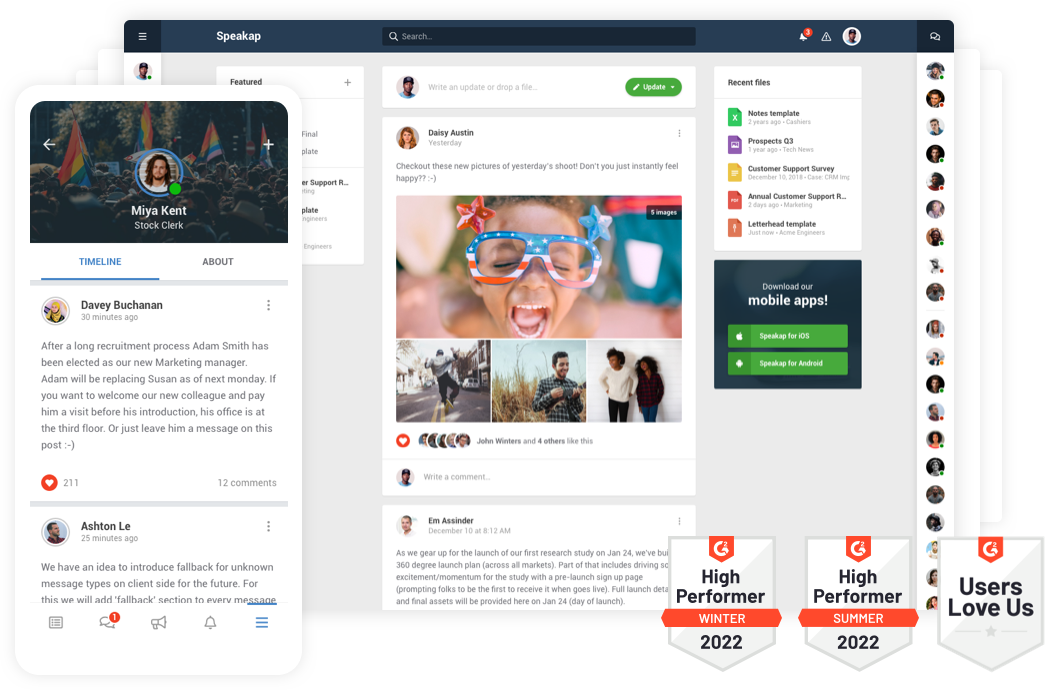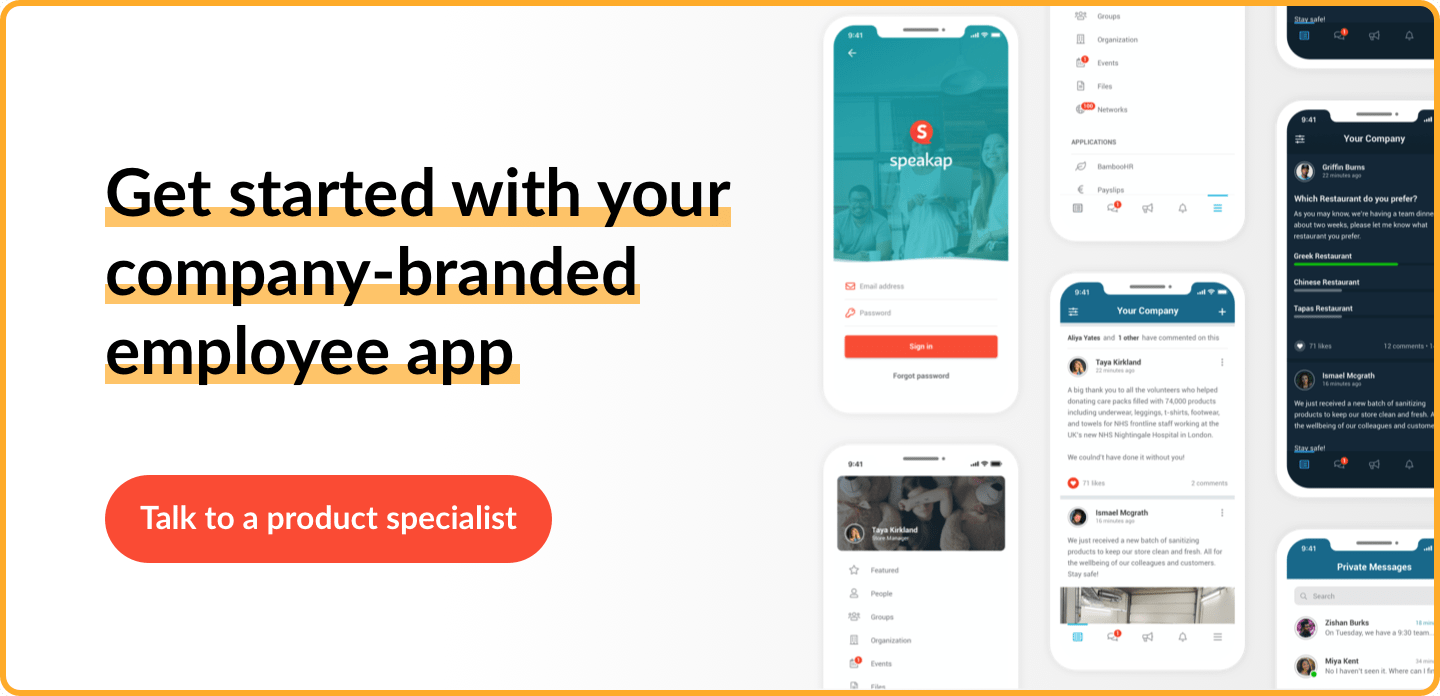Top 10 Internal Communication Tools to Consider
Effective communication is the backbone of a successful business. It serves as a bridge to connect employees from all areas of the company and encourages their active engagement. In a fast-paced business environment, it is critical that all employees, regardless of their job roles, feel valued and well-informed. This is why internal communication solutions are necessary to ensure that projects are completed efficiently, on time, and within budget constraints. Therefore, every business must prioritize effective communication to achieve success.
Frontline sectors, like the construction industry, exemplify the critical role of communication. A recent study underscores that "effective communication, as a way to exchange thoughts, messages, or information by speech, signal, and writing, has a pivotal role in construction projects." Furthermore, the study highlights the significant impact of a company's tech familiarity on enhancing communications. Organizations that harness the power of effective internal communication tools experience greater investment and productivity from core stakeholders.
How can collaboration tools improve team communication?
Collaboration tools serve as centralized platforms where teams can exchange messages, share files, and collaborate on projects in real-time. By consolidating communication channels within a single interface, these tools eliminate the need for scattered emails and disjointed instant messaging tools and apps. This streamlining enhances the efficiency of team communication, reduces information silos, and ensures that everyone is on the same page.
Besides, with the increasing prevalence of remote work and global teams, geographical barriers should not hinder effective communication. Collaboration tools transcend physical locations, enabling employees to collaborate seamlessly, whether they are working in the same office or on opposite sides of the world. This inclusivity fosters a sense of unity among team members, regardless of their physical presence.
In addition, collaboration tools provide instant notifications and updates, ensuring that important messages are never missed. Team members can receive push notifications about project milestones, deadlines, or urgent matters, allowing for timely responses and informed decision-making. These real-time features enhance the agility of teams and contribute to a proactive work culture.
Finally, effective team communication goes beyond one-way messaging. Collaboration tools often include features for employee surveys and feedback collection. By actively seeking input from team members, organizations can gauge employee satisfaction, identify areas for improvement, and tailor their internal communications strategy accordingly. This two-way dialogue empowers employees and demonstrates a commitment to their voices being heard.
Key considerations for choosing the right communication tools
Selecting the best internal communication tools is a crucial decision for organizations seeking to create a dynamic and connected workforce. These are the key considerations that should guide your choice of the best internal communication tool:
Alignment with organizational goals
To ensure that the chosen communication tools align with your organizational goals, it's crucial to have a clear understanding of your company's strategic priorities. If your goal is to enhance employee engagement, look for communications tools that emphasize features like employee feedback mechanisms, real-time updates, and collaboration spaces. These tools should contribute directly to achieving your desired outcomes, whether it's improving internal communication, fostering a culture of transparency, or streamlining workflows.
User-friendly interface
An intuitive and user-friendly interface is essential for employee engagement. When employees find it easy to navigate and use communication tools, they are more likely to embrace them wholeheartedly. Consider conducting user testing or seeking feedback from employees during the selection process to ensure that the interface meets their needs and preferences. Prioritizing usability can lead to higher adoption rates and improved satisfaction among your workforce.
Accessibility across devices
Employees may need to access information and engage with colleagues on the go. By choosing communication tools that are compatible with various devices, you empower your workforce to stay connected and engaged, whether they are working from the office, remotely, or while traveling. This flexibility contributes to a seamless and inclusive communication experience.
Seamless integration
Seamless integration with existing systems is crucial for streamlining workflows and ensuring a cohesive employee experience. Your HR software, project management tools, and other essential platforms should work harmoniously with the chosen internal communication software and tools. This integration minimizes the need for manual data entry, reduces administrative burdens, and enhances the overall efficiency of your organization's processes. When systems work together seamlessly, employees can focus on meaningful tasks and collaboration.
Customization options
Every organization has its unique communication needs and branding preferences. Look for communication tools that offer customization options to tailor the user experience to your own company culture's specific requirements. Whether it's customizing the platform's appearance to align with your brand or configuring user access levels to control information dissemination, these customization options empower you to create a communication environment that resonates with your corporate culture and objectives. Customization fosters a sense of ownership and personalization among employees.
Multimedia capabilities
Effective communication often requires more than words. The ability to incorporate multimedia content such as images, videos, and documents into internal newsletters enriches the communication experience. Employees can better understand complex topics, engage with training materials, and express ideas creatively. By leveraging multimedia capabilities, you create dynamic and engaging internal communications that capture and retain employees' attention, resulting in a more vibrant and interactive work environment.
Top 10 internal communication tools
Amidst a myriad of technology-aided apps and services, selecting the best internal communication tools for your team can seem overwhelming. To help you make an informed decision tailored to your organizational needs, here is a closer look at the top 10 internal communication tools available in the market today. Each tool comes with its unique strengths and challenges, ensuring you can find the perfect fit to facilitate seamless communication, enhance employee knowledge management engagement, and drive business success.

Speakap
Speakap stands out by focusing on real-time connections between office and frontline workers. It eliminates the need for clunky desktop software and creates a social network where users can interact continuously at all project stages, regardless of location or time zone. With features that encompass company news, collaboration tools, and a mobile-first approach, Speakap ensures that your entire workforce stays connected and engaged.
Whichever types of internal communication and tool you choose, be sure that the service offers a mobile extension to accommodate device availability and WiFi connectivity on sites, and includes features that are easily accessible by both office and field workers. With the right app in tow, you can dramatically enhance your productivity and instill a sense of community and pride company-wide that will yield better results, higher morale, and stronger employee retention.

Zoom
While tools like Zoom have been crucial for remote communication during the pandemic, it's essential to recognize that not all tools are ideal for field workers. Construction crews, for example, often require more than an instant messaging tool or just a visual interface for effective communication. Selecting a communication tool that caters to the specific needs of your workforce will lead to improved employee engagement, higher job satisfaction, and a cohesive workplace community.

Google Hangouts & Google Meet
These tools offer end-to-end video communication and in-app chat, making them suitable for both personal and enterprise use. However, they have some file-sharing limitations, and all participants in video chat tool must have a Gmail account or be Google users, potentially creating barriers and security concerns when connecting with all employees

Slack
Slack excels in both instant messaging and text-based communication, facilitating collaboration through chat, file exchange, calls, and custom channels. It integrates seamlessly with many internal communication tools, such as Google Drive, Dropbox, Asana, Salesforce, Zendesk, and more. However, it may have limited accessibility for remote employees, hindering real-time interactions for frontline workers.

Microsoft Teams
Microsoft Teams is a comprehensive solution that consolidates digital conversations, meetings, and video conferencing within the Microsoft 365 platform. It seamlessly integrates with internal email corporate communication tools, offering advantages for businesses familiar with the Microsoft ecosystem. However, its flexibility for customization and scalability to specific project needs may be limited.

Workplace by Facebook
This internal communication tool shares similarities with Microsoft Teams, providing robust digital conversations and collaboration capabilities. However, it offers fewer third-party integrations, which can impact its ability to adapt to various project requirements. With two types of chat for updates and Workchat, managing multiple ongoing projects and tracking new posts and comments may become challenging.

Trello & Asana
Trello and Asana are renowned for their project management capabilities, focusing on assigning and tracking tasks efficiently. While they offer in-app comments for user interactions, they primarily serve as office-driven tools. This limitation can pose challenges for remote teams and workers in the field, making it challenging to stay updated and engaged with ongoing projects.

Bananatag
Bananatag specializes in email tracking and integrates with various email clients, including Outlook, Gmail, Yahoo, and Mac. It excels in link and attachment tracking, scheduling, and analytics. However, its primary focus is on targeted responses and email-related internal communications tools, rather than two-way communication within a broader corporate context.
Make your decision
To bridge the gap between project management and internal communication, consider implementing a comprehensive internal communication platform or corporate communication platform that integrates seamlessly with project management tools. This ensures that both office and frontline workers can collaborate effectively, receive real-time updates, and engage in meaningful interactions. Such a platform, especially when accessible via a mobile-first employee app, serves as a single source for all company information, promoting streamlined communication, enhanced productivity, employee feedback apps, and a cohesive workforce, regardless of their location or role. That platform is Speakap. Book a free demo now.


